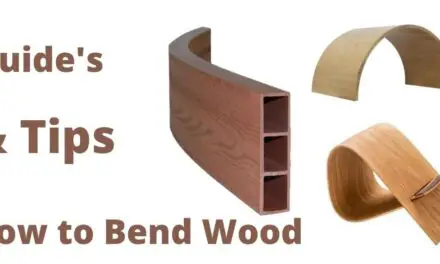To fill gaps in woodworking, use wood filler or epoxy resin to fill in the spaces and then sand it down to create a seamless finish. Filling gaps in woodworking requires the use of wood filler or epoxy resin, which can be applied to the gaps and sanded down to create a smooth and even surface.
This process helps to enhance the overall appearance and durability of the woodwork, ensuring a high-quality finish. Woodworkers often utilize this technique to fill gaps in furniture, cabinetry, or other wooden structures. By following these steps, you can easily fill gaps in your woodworking projects and achieve professional-looking results.
Understanding Wood Gaps
Discover effective techniques for filling gaps in woodworking projects with this comprehensive guide on understanding wood gaps. Gain valuable insights and learn step-by-step methods to achieve seamless finishes in your woodworking projects.
Woodworking projects often involve joining pieces of wood together to create a beautiful and functional piece. However, it is not uncommon to encounter gaps between these wood joints. Understanding the different types of wood gaps and their causes will help you fill them with precision, ensuring a seamless and professional finish to your woodworking projects.
Let’s dive into the details:
Different Types Of Wood Gaps:
- Shrinkage gaps: These gaps occur as a result of the natural drying and shrinking of the wood. Wood has a tendency to contract as it loses moisture, leaving small gaps between the joints. Shrinkage gaps are common in freshly sawn or kiln-dried wood.
- Expansion gaps: On the other hand, wood can also expand when exposed to moisture or changes in humidity. Expansion gaps occur to accommodate this expansion and prevent the wood from warping or splitting. These gaps tend to close up when the moisture content in the wood stabilizes.
- Joinery gaps: Joinery gaps can occur due to imprecise joinery techniques or errors in cutting and fitting the wood joints. These gaps can be seen in dovetail joints, mortise and tenons, or finger joints. Proper planning, measuring, and skillful execution are essential in minimizing joinery gaps.
Causes Of Wood Gaps:
- Moisture content: Wood that is not properly seasoned or has a high moisture content will likely experience more shrinkage gaps as it dries. On the other hand, wood that becomes too moist can expand and lead to expansion gaps. Understanding and controlling the moisture content of the wood is crucial in minimizing gaps.
- Incorrect joinery techniques: Improper execution of joinery techniques can result in visible gaps between the wood joints. Sloppy cuts, incorrect angles, or poor measurements can all contribute to joinery gaps. Accuracy, attention to detail, and practicing precise joinery techniques can help alleviate this issue.
- Natural wood movement: Wood is a living material that expands and contracts in response to changes in temperature and humidity. Understanding the natural movement of the wood and allowing for it in your woodworking projects can help prevent unnecessary gaps.
- Seasonal changes: Wood gaps may appear or disappear with seasonal changes in humidity. As the humidity levels fluctuate, the wood will expand or contract accordingly, causing gaps to close up or reappear. Be mindful of these changes and plan your woodworking projects accordingly.
Understanding the different types of wood gaps and their causes is the key to filling them effectively. Whether it’s through proper wood selection, accurate joinery techniques, or allowing for natural wood movement, taking the necessary steps will help you achieve a flawless finish in your woodworking projects.
So, embrace the challenges that wood gaps present and turn them into opportunities to refine your craftsmanship.
Tools And Materials Needed
To fill gaps in woodworking, you’ll need some essential tools and materials. These include wood filler, putty knife, sandpaper, a fine-tip brush, and matching stain or paint. With these items, you can seamlessly repair and fill gaps in your woodworking projects.
Essential Tools For Gap Filling:
- Putty knife: A putty knife is a versatile tool used for applying and smoothing fillers. It helps to scrape away any excess material and create a smooth finish on the wood surface.
- Chisel: A sharp chisel is necessary for removing any loose or damaged wood around the gap. It allows for precise shaping and preparation of the gap before filling.
- Sandpaper: Sandpaper is essential for smoothing the surface of the wood after gap filling. It helps to blend the filled area with the surrounding wood and create a seamless finish.
- Clamps: Clamps are useful for holding the wood pieces together while the filler dries. They ensure that the gap remains closed and the filler adheres properly.
- Wood glue: Wood glue is essential for bonding the wood pieces together. It provides a strong and durable hold, ensuring that the filler remains in place.
Recommended Materials For Gap Filling:
- Wood filler: Wood filler is a preferred material for filling gaps in woodworking projects. It is available in various colors to match the wood and can be easily shaped and sanded.
- Epoxy resin: Epoxy resin is a strong, durable, and waterproof material that is suitable for filling larger gaps or repairing damaged wood. It creates a solid, long-lasting bond.
- Sawdust and glue mixture: A mixture of sawdust and wood glue can be used as a homemade filler. It allows for a more natural look, as the color can be matched to the wood, and it is cost-effective.
- Colored wax fillers: Colored wax fillers are ideal for small, shallow gaps as they provide a quick and easy solution. They can be melted and applied to the gap, then buffed to blend with the wood.
- Wood shavings: Wood shavings can be mixed with wood glue to create a filler for larger gaps. They provide a natural appearance and can be sanded and shaped like the surrounding wood.
Having the right tools and materials is crucial when it comes to filling gaps in woodworking. The essential tools, such as a putty knife, chisel, sandpaper, clamps, and wood glue, allow for precise preparation and application of fillers. Recommended materials, such as wood filler, epoxy resin, sawdust and glue mixture, colored wax fillers, and wood shavings, provide options for different gap sizes and desired finishes.
Choose the appropriate tools and materials based on the specific woodworking project to achieve professional-looking results.
Preparing The Wood Surface
To fill gaps in woodworking, it is important to properly prepare the wood surface. This involves cleaning the surface, removing debris, sanding any rough areas, and ensuring a smooth and even base for filling the gaps with wood filler or epoxy.
Woodworking projects often involve joining pieces of wood together. However, sometimes there can be gaps or imperfections in the wood surface that need to be filled. In this section, we will discuss the important steps involved in preparing the wood surface before filling the gaps.
Cleaning And Sanding The Wood:
- Start by cleaning the wood surface using a mild detergent and a soft cloth. This will remove any dirt, dust, or grease, allowing the filler to adhere properly.
- Next, sand the wood surface using sandpaper with a fine grit. Sanding helps to smooth out any rough areas and creates a better surface for the filler to bond with.
- Be sure to follow the grain of the wood while sanding, applying gentle pressure. This will prevent any scratches or damage to the wood.
- After sanding, use a tack cloth to remove any sanding residue. This will ensure a clean surface for applying the filler.
Removing Debris And Old Filler:
- Before applying any new filler, it is essential to remove any debris or old filler from the gaps. Use a chisel or a putty knife to carefully scrape out any loose material.
- Be gentle while removing the debris to avoid causing further damage to the wood surface.
- Ensure that the gaps are completely clean and free from any remnants of the old filler. This will allow the new filler to adhere properly and provide a seamless finish.
By following these steps to prepare the wood surface, you will create the ideal foundation for filling the gaps in your woodworking project. Cleaning and sanding the wood will ensure that the filler adheres properly and provides a smooth, professional-looking finish.
Choosing The Right Filler
When filling gaps in woodworking, it is important to choose the right filler. Consider the type of wood, the size of the gaps, and the desired finish to select the best filler for your project.
When it comes to woodworking, one common challenge is dealing with gaps that may appear in your projects. Whether it’s due to irregularities in the wood or changes in humidity, these gaps can be unsightly and compromise the overall appearance of your work.
Thankfully, there are various fillers available to help address this issue. Choosing the right filler is crucial for achieving a seamless finish and ensuring the longevity of your woodworking projects. Here are the key factors to consider when selecting the appropriate filler:
Types Of Fillers Available
There are several types of fillers that you can choose from, each with its own characteristics and suitability for different woodworking applications. Here are some popular options:
- Wood Putty: This versatile filler is composed of a combination of wood fibers and a binding agent. Wood putty is ideal for small gaps and holes, as it can be easily molded and shaped to match the surrounding wood grain. It is available in a wide range of colors to match specific wood species, making it almost invisible when properly applied and sanded.
- Wood Filler: Similar to wood putty, wood filler is a paste-like substance designed to fill gaps and imperfections in wood surfaces. Its composition varies, with some fillers being solvent-based while others are water-based. Wood filler is suitable for larger gaps and cracks, as it can be spread evenly over a larger area. Once cured, it can be sanded and painted or stained to achieve a flawless finish.
- Epoxy: Epoxy fillers are a popular choice for filling gaps in woodworking due to their durability and strength. These two-part products consist of a resin and a hardener, which must be mixed together before application. Epoxy fillers are incredibly strong and can withstand heavy loads, making them ideal for structural repairs. Additionally, epoxy can be tinted to match different wood species and is resistant to shrinking or cracking over time.
- CA Glue: Also known as cyanoacrylate adhesive, CA glue is primarily used as an adhesive but can also be utilized to fill small gaps in woodworking. When applied to a gap, CA glue quickly cures into a hard substance, which can be sanded and finished like regular wood. It is important to note that CA glue sets very rapidly, so it is recommended to work in small sections to avoid accidental bonding.
- Compressed Wood Fibers: Made from compressed wood particles and resin, this filler is commonly used for larger gaps and holes in the wood. It is available in powder form and can be mixed with water or a bonding agent to create a paste. Compressed wood fibers are strong and easy to work with, allowing for simple application and sanding.
Selecting the appropriate filler for your project is crucial to ensure a professional and durable finish. Consider the size and nature of the gap, the color matching requirements, as well as the desired longevity and strength of the filler. By understanding the different types of fillers available and their specific characteristics, you can confidently choose the right one for your woodworking needs.
Applying The Filler
Looking to fill gaps in your woodworking projects? Learn how to apply filler effectively with these simple tips and techniques. Enhance the beauty and durability of your woodwork by following these step-by-step instructions.
Woodworking is a craft that requires precision and attention to detail. One common challenge faced by woodworkers is filling gaps in their projects. Whether it’s small cracks or large voids, applying filler can help to achieve a smooth and flawless finish.
In this step-by-step guide, we will explore the techniques for filling gaps in woodworking and how to apply the filler effectively.
Step-By-Step Guide To Applying Filler:
- Prepare the surface:
- Ensure that the wood surface is clean and free from any dirt or debris.
- Sand the area around the gap lightly to create a rough surface that allows better adhesion of the filler.
- Choose the right filler:
- Select a wood filler that matches the color and grain of the wood. This will help the filled gap blend seamlessly with the surrounding wood.
- Consider the size of the gap when choosing the filler. For small cracks, a paste-like filler may work best, while for larger gaps, a putty-like filler would be more suitable.
- Mix the filler (if required):
- Some wood fillers come as two-part systems that need to be mixed together before use. Follow the manufacturer’s instructions to ensure proper mixing.
- Apply the filler:
- Use a putty knife or a small, flexible spatula to apply the filler to the gap.
- Start by pressing the filler into the gap, making sure it fills the entire void.
- Smooth out the excess filler using the edge of the putty knife or spatula. Blend it with the surrounding wood surface for a seamless finish.
- For larger gaps, apply the filler slightly above the surface level to allow for shrinkage during drying.
- Allow the filler to dry:
- Follow the manufacturer’s instructions for drying time. It typically ranges from a few minutes to a few hours.
- Avoid touching or disturbing the filler during the drying process to ensure a smooth and even finish.
- Sand the filled area:
- Once the filler is completely dry, use sandpaper to smooth out the filled area.
- Start with a coarse-grit sandpaper to level the filler with the surrounding wood.
- Gradually switch to finer grits to achieve a smooth and polished finish.
- Clean the surface:
- After sanding, clean the surface of any dust or debris using a soft, dry cloth or a gentle brush.
- Apply a finish:
- If desired, apply a suitable finish such as stain, varnish, or paint to the filled area to match the rest of the project.
By following these step-by-step instructions, you can effectively fill gaps in your woodworking projects and achieve a professional-looking result. Remember to choose the right filler, apply it carefully, and take the time to sand and finish the filled area for a flawless finish.
Happy woodworking!
Sanding And Smoothing
Learn how to fill gaps in woodworking with sanding and smoothing techniques. Achieve a seamless finish by carefully addressing imperfections in your wood projects.
Sanding The Filled Gaps
When it comes to filling gaps in woodworking, achieving a smooth and seamless finish is essential to create a polished and professional look. Sanding plays a crucial role in this process, allowing you to level the filled gaps and create a seamless surface.
Here’s what you need to know about sanding and smoothing your woodworking projects:
- Sandpaper Selection: Start by choosing the right sandpaper grit for the job. Lower-numbered grits like 80 or 100 are ideal for heavy sanding and leveling uneven surfaces, while higher-numbered grits like 180 or 220 are better for fine sanding and smoothing.
- Sanding Technique: Begin sanding the filled gaps using steady, even strokes in the same direction as the wood’s grain. Apply moderate pressure, but be careful not to oversand and remove too much material.
- Feathering the Edges: To achieve a seamless transition between the filled gaps and the surrounding wood, feather the edges by gradually reducing the pressure and sanding the area around the gap. This ensures a smooth blend and prevents noticeable transitions.
- Check for Levelness: Regularly check the levelness of the filled gaps by running your hand over the surface. If you feel any unevenness, continue sanding until the surface is consistently smooth and even.
- Progress to finer grits: Once you have leveled the filled gaps, switch to a higher-grit sandpaper. This helps to refine the surface further and remove any remaining roughness. Sand the entire project with the same finer grit to ensure consistency in texture.
- Sanding Smaller Gaps: When sanding smaller gaps, such as nail holes, you can use specialized sanding tools like sanding sticks or sanding sponges. These tools allow for more precise sanding in tight or intricate areas.
- Dust Control: Wood dust can be harmful, so it’s essential to take appropriate safety measures. Always wear a dust mask, use a dust collection system, or work in a well-ventilated area to minimize the inhalation of fine wood particles.
- Grain Matching: Sanding can affect the wood’s appearance, particularly when it comes to visible grain patterns. Pay attention to the direction of the wood grain and adjust your sanding technique accordingly to match the surrounding wood.
- Finishing Touches: After sanding, wipe away any residual dust with a damp cloth or vacuum cleaner. You can then proceed to apply the desired finish, such as varnish or paint, to complete your woodworking project.
By following these sanding and smoothing techniques, you can fill gaps in woodworking and achieve a professional, polished finish that showcases your craftsmanship. Sanding is a crucial step in the process, and with the right tools and techniques, you can create a seamless and beautiful end result.
Staining And Finishing
Learn how to fill gaps in woodworking with staining and finishing techniques. Enhance the appearance and durability of your wood projects by seamlessly filling gaps for a flawless finish.
Applying Stain To Match The Wood Color
When it comes to filling gaps in woodworking, applying stain can be a valuable technique to ensure a seamless finish. By matching the wood color, you can create a cohesive look that hides any gaps or imperfections. Here’s how you can effectively apply stain to achieve a flawless result:
- Choose the right stain color: Begin by selecting a stain color that closely matches the existing wood color. Test the stain on a small, inconspicuous area to ensure it blends well.
- Prepare the surface: Clean the wood surface thoroughly to remove any dirt, dust, or debris. Sand the area around the gap lightly to create a smooth texture and improve stain absorption.
- Apply the stain: Using a clean cloth or foam brush, apply the stain to the gap in a consistent and even manner. It’s important to follow the grain of the wood for a natural finish. Allow the stain to penetrate the wood for the recommended time mentioned on the product label.
- Wipe off excess stain: After the recommended time, use a clean cloth to wipe off any excess stain. This step helps to prevent blotching and ensures an even color distribution.
- Allow the stain to dry: Give the stain ample time to dry completely before proceeding with any further steps. This may take several hours or even overnight, depending on the specific stain product used.
- Assess the color match: Once the stain is dry, evaluate the color match. If necessary, you can repeat the application process to deepen or adjust the color until it seamlessly blends with the surrounding wood.
Adding A Protective Finish
To ensure the longevity of your woodworking project and provide added protection, it’s essential to apply a protective finish. This step not only enhances the appearance but also guards against wear, moisture, and other potential damages. Here’s how you can add a protective finish to your project:
- Choose the right finish: There are various finishes available, such as polyurethane, lacquer, shellac, or oil-based finishes. Consider the type of wood, desired finish sheen, and level of durability when selecting the appropriate finish.
- Prepare the surface: Just like with staining, preparing the surface is crucial. Make sure the wood is clean, smooth, and free from any dust or debris. Sanding the wood with fine-grit sandpaper can help achieve a smooth finish.
- Apply the finish: Use a brush, cloth, or sprayer to evenly apply the finish, following the manufacturer’s instructions. Start in one corner and work your way across, ensuring full coverage. Be cautious of any drips or pooling that can result in an uneven finish.
- Allow drying and curing: Allow the finish to dry as per the product instructions. Some finishes may require multiple coats, with sanding between each coat for a smoother result. Curing time can vary, so be patient and avoid using or placing objects on the finished surface until fully cured.
- Sand and buff (optional): If desired, you can sand the finish lightly with fine-grit sandpaper and polish it using a buffing compound or wax. This step can enhance the smoothness and shine of the finish.
- Regular maintenance: To keep your woodworking project in optimal condition, periodic maintenance may be necessary. Follow the recommended care instructions for the specific finish used, such as routine cleaning, reapplication of protective coatings, or touch-ups as needed.
By applying stain to match the wood color and adding a protective finish, you can effectively fill gaps in woodworking while achieving a professional and polished look. Remember to select the right products, follow proper application techniques, and maintain the finished project for long-lasting results.
Blending The Filler With The Wood
Learn the art of blending fillers with wood to seamlessly fill gaps in woodworking projects. Discover effective techniques to create a smooth, flawless finish without compromising the natural beauty of the wood.
Techniques For Blending Filler With Surrounding Wood
Blending the filler with the wood is essential to achieving a seamless finish that hides any gaps or imperfections. Here are some techniques to help you blend your filler with the surrounding wood effectively:
- Choose the right filler: Opt for a filler that matches the color and texture of the wood as closely as possible. This will make it easier to blend it in.
- Mixing colors: If you can’t find a filler that perfectly matches your wood, consider mixing different colors to create a custom shade. Experiment on a small test piece before applying it to your project.
- Application technique: Use a putty knife or a small spatula to apply the filler into the gap. Ensure it fills the entire depth of the gap without leaving any air pockets.
- Smooth and level: After applying the filler, use the edge of the putty knife to level it with the surface of the wood. Smooth it out gently to avoid any excess filler on the surrounding wood.
- Feathering technique: To achieve a natural appearance, gently feather the edges of the filler into the surrounding wood. This will help create a seamless transition without any noticeable edges.
- Sanding: Once the filler has dried completely, use sandpaper to smooth the surface. Start with a coarse-grit sandpaper and gradually move to finer grits for a polished finish. Sand in the direction of the wood grain to avoid any scratches.
- Staining or finishing: If required, apply a matching stain or finish over the filled area to further enhance the blend.
By using these techniques, you can achieve a flawless finish that seamlessly blends the filler with the wood, making any gaps or imperfections virtually invisible. Experiment with different approaches to find the one that works best for your project.
Final Touches And Detailing
Achieve flawless woodworking with expert advice on filling gaps. Discover the final touches and detailing techniques to seamlessly mend any woodwork imperfections.
Once you’ve filled the gaps in your woodworking project, it’s time to focus on the final touches and detailing. This is where you can truly enhance the overall look of your creation and make it stand out. Here are some tips to help you achieve that perfect finish:
Touching Up Any Imperfections
- Check for any remaining imperfections in the wood surface and address them accordingly.
- Use a fine-grit sandpaper to smooth out any rough areas or uneven surfaces.
- Apply wood putty to fill in any remaining gaps or holes, making sure to choose a shade that matches the surrounding wood.
- Scrape off any excess putty and allow it to dry completely.
- Once dry, sand the putty surface until smooth, blending it seamlessly with the surrounding wood.
- Use a damp cloth to wipe away any dust or debris from the sanding process.
Enhancing The Overall Look Of The Project
- Apply a wood finish or stain to protect the wood and enhance its natural beauty.
- Choose a finish that complements the wood species and desired look of your project.
- Use a brush or cloth to apply the finish in even strokes, following the direction of the wood grain.
- Allow the finish to dry according to the manufacturer’s instructions before applying additional coats if desired.
- Consider adding layers of varnish or polyurethane for added protection and a glossy finish.
- Pay attention to any intricate details or decorative elements on your project, ensuring they are properly finished and highlighted.
- Consider adding decorative elements such as inlays or wood burnings to enhance the overall aesthetic.
Remember, the final touches and detailing are what truly bring a woodworking project to life. Take the time to address any imperfections and enhance the overall look, and your finished piece will shine with craftsmanship and beauty.
Tips And Tricks For Successful Gap Filling
Discover effective tips and tricks for successful gap filling in woodworking. This comprehensive guide provides valuable insights on how to fill gaps in woodwork seamlessly, ensuring a flawless finish. Explore expert techniques to achieve professional-looking results with ease.
Woodworking projects often require filling gaps to achieve a smooth and polished finish. Whether you’re a seasoned professional or a DIY enthusiast, mastering the art of gap filling is essential in creating flawless woodwork. To help you achieve professional results, here are some tried and tested tips and tricks:
Common Mistakes To Avoid
- Rushing the process: Taking your time during the gap filling process is crucial. Rushing can lead to errors and result in unsightly finishes. So, be patient and meticulous throughout the entire process.
- Neglecting proper preparation: Filling gaps requires proper preparation. Ensure the surfaces are clean, dry, and free from debris before applying any filler. This will help the filler adhere better and provide a seamless finish.
- Overfilling gaps: Overfilling gaps can lead to additional sanding and a less natural appearance. It’s important to follow the instructions provided with the filler and apply it in a controlled manner to achieve the desired results.
- Failing to color match: If the wood piece you are working on is stained or painted, it is essential to match the color of the filler to the existing finish. Take the time to choose the right shade to ensure a seamless blend.
- Incorrect sanding technique: Sanding plays a crucial role in achieving a smooth and even surface. Use the appropriate grit sandpaper, and move in the direction of the wood grain. Avoid sanding too aggressively, as it can damage the surrounding area.
Expert Advice For Professional Results
- Choose the right filler: Different types of fillers are available, including wood putty, epoxy, and wood filler. Select a filler that matches the project’s requirements, such as the size of the gap and the type of wood being worked on.
- Test the filler first: Before applying the filler to the actual gap, it’s always recommended to perform a test on a scrap piece of wood. This will help you determine the drying time, shrinkage, and color suitability of the filler.
- Apply filler in multiple layers: For larger gaps, it’s best to apply the filler in multiple layers rather than trying to fill it all at once. By allowing each layer to dry and sanding in between, you can achieve a smoother and more natural finish.
- Sand with care: Sanding is necessary to achieve a seamless blend between the filled gap and the surrounding wood. Use a fine grit sandpaper and make sure to feather the edges of the filled area for a smooth transition.
- Finish with precision: Once the filler has dried and sanded, apply the appropriate finish to protect the wood and enhance its appearance. Choose a finish that matches the surrounding woodwork to ensure a cohesive look.
By following these tips and tricks, you can fill gaps in your woodworking projects like a pro. Remember to take your time, choose the right materials, and pay attention to detail. With practice and patience, you’ll achieve flawless results that will impress even the most discerning eyes.
Frequently Asked Questions On How To Fill Gaps In Woodworking?
What Can I Use To Fill Gaps In Wood Walls?
To fill gaps in wood walls, you can use wood filler or putty. These products can seamlessly merge with the surrounding wood surface and provide a smooth finish. You simply apply the filler or putty into the gaps or holes, ensuring it is level with the wall’s surface.
Allow it to dry according to the manufacturer’s instructions, then sand it down to create an even finish. Once sanded, you can paint or stain the filled areas to match the rest of the wall. It’s important to choose a filler or putty that matches the color and type of wood you are working with.
Regular maintenance and periodic inspections will help keep your wood walls in good condition.
How Do You Fill Gaps With Sawdust?
To fill gaps with sawdust, begin by collecting a small amount of sawdust that matches the color of your wood. Next, apply wood glue to the gap, filling it about halfway. Sprinkle the sawdust onto the glue, making sure to cover the entire area.
Gently press the sawdust into the glue to ensure a secure bond. Allow the glue to dry completely, and then use a sandpaper block to smooth out any uneven surfaces. Finally, wipe away any excess sawdust, and apply a finish or stain to match the surrounding wood.
This simple technique helps to seamlessly blend gaps in woodwork and achieve a professional finish.
How To Fill Gaps In Woodworking?
To fill gaps in woodworking, start by cleaning the gap and removing any loose debris. Use wood filler or epoxy fillers to fill the gap, ensuring it matches the wood grain and color. Allow it to dry, then sand it down until smooth.
Finish by applying a protective coating to match the surrounding wood.
Why Do Gaps Appear In Woodworking Projects?
Gaps can appear in woodworking projects due to factors such as wood movement, improper joinery, or natural shrinkage. Wood expands and contracts with changes in temperature and humidity, which can cause gaps to form over time. Using appropriate joinery techniques and considering wood movement can help minimize gap formation.
Conclusion
In essence, filling gaps in woodworking is a common task that can be easily accomplished with the right techniques and tools. By selecting the appropriate filler material, preparing the surface properly, and applying the fill in a precise manner, you can achieve seamless and professional-looking results.
Remember to take into consideration the type of wood and the size of the gap when choosing a filler. Whether you opt for a wooden filler, epoxy, or even a DIY concoction, make sure to follow the manufacturer’s instructions and test the filler on a small area first.
With practice and patience, you can master the art of gap filling in woodworking, enhancing the overall aesthetics and durability of your projects. So next time you encounter gaps in your woodworking, don’t despair, embrace the opportunity to showcase your expertise and craftsmanship by seamlessly filling them.



















